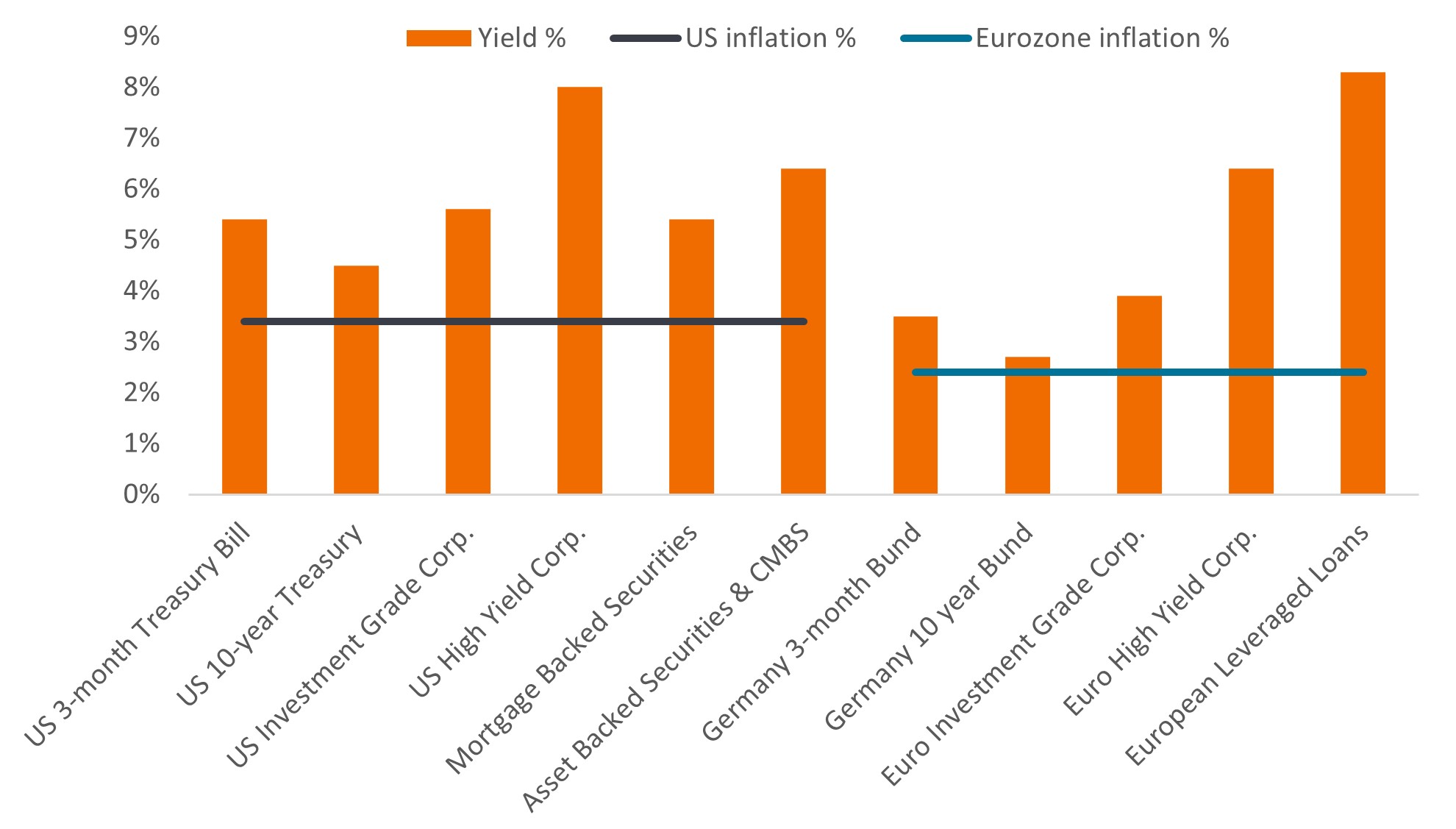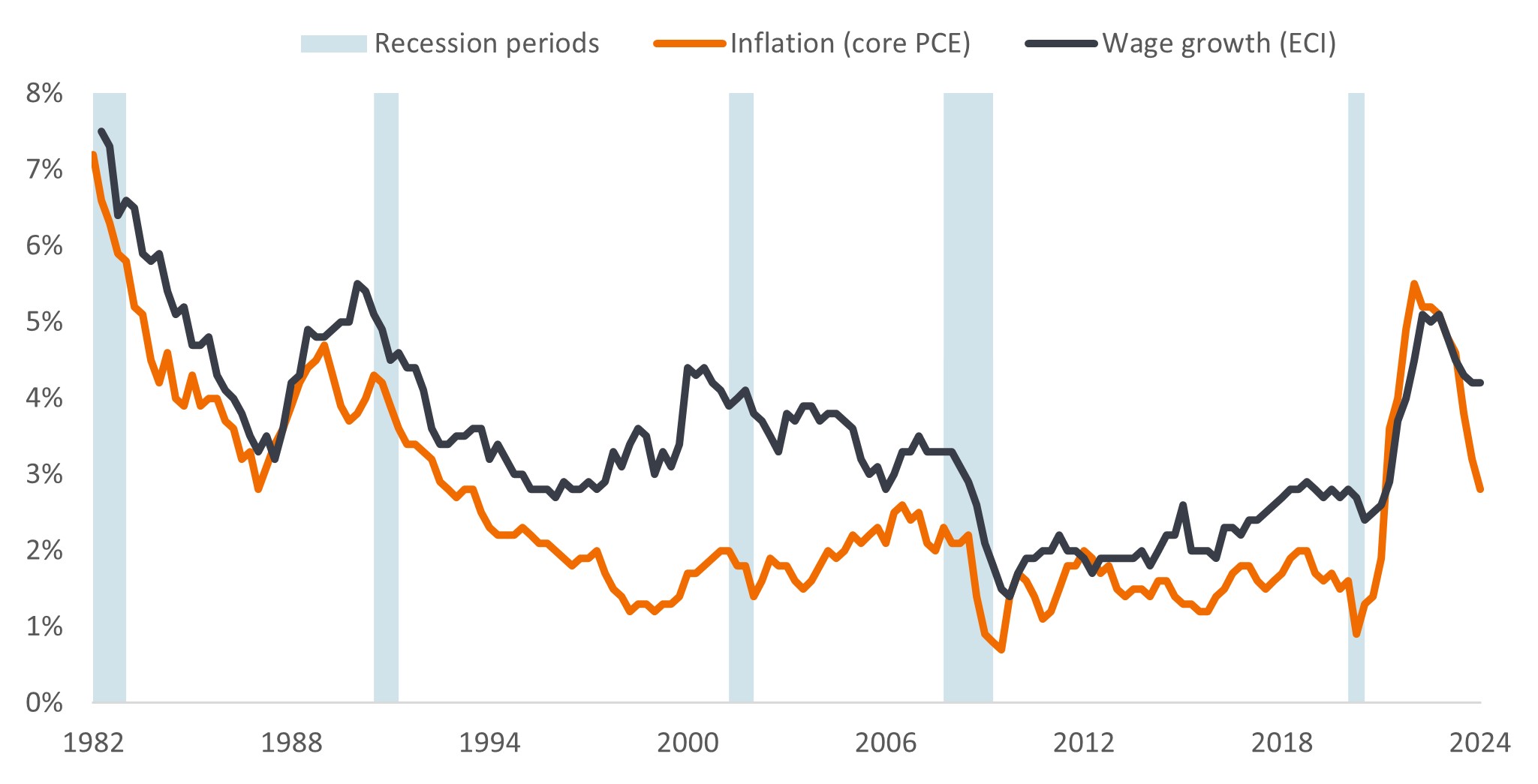固定收益展望:等待减息的同时获取进账
全球固定收益主管Jim Cielinski在年中展望中承认,市场急不及待地希望减息,但这也带来新的机会,让投资者能够获得具吸引力的孳息率。

9 分钟阅读
焦点分析
- 市场已经推迟对减息时间及步伐的预期,但这创造了锁定固定收益具吸引力孳息率的机会。
- 核心通胀正在接近央行的目标,而主要央行意识到政策行动存在滞后性后,应当会着手进行减息。
- 固定收益市场普遍预计经济将会实现软着陆,而投资者应当寻找能够提供价值,但不会在经济硬着陆情况下遭受重挫的领域。
有一个著名的笑话,一位在爱尔兰迷路的游客向一名当地人询问前往都柏林的路线,当地农民皱着眉头回答道:「好吧,先生,如果我是您,就不会从这里开始走。」
几年前的固定收益投资者会对此深有同感。当时孳息率处于历史低位,上涨的可能性较大,而债券提供的收益有限。如今,固定收益市场情况截然不同。目前的孳息率水平高于通胀,且在利率下降的情况下更可能带来资本收益。
因此,对于寻求具吸引力回报的投资者,此时是入市良机。我们认为,未来六个月,固定收益极有可能同时带来不俗的收益及若干额外资本增值。
减息未如预期起步,但货币宽松正在进行中
固定收益市场一直聚焦减息的时间。这不仅需要关注经济及通胀数据,而且需要关注政策制定者本身。市场并不指望央行糟糕的预测能力。相反,市场重视央行是因为他们负责制定政策。
央行明确承认自己缺乏预见力,因此高度「依赖数据」及保守。问题是央行关注的主要指标(通胀及就业)属于滞后指标。更糟糕的是,央行的政策工具同样具有滞后性。由于通胀居高不下,市场重新调整对减息次数的预期,预计联储局将于本年度减息1或2次,而非年初预计的6至7次1。若未来数月通胀表现与预期不符,该作法将导致政策失误。
推迟减息的必然结果是固定收益投资者有更多机会锁定具吸引力的孳息率。投资者在等待减息的同时获取进账
图1:收益孳息率高于通胀率

资料来源:彭博,通胀率,截至2024年4月30日的按年变动%:美国所有城市消费者所有项目的消费物价指数、欧元区消费物价调和指数。截至2024年5月31日的孳息率(按时间顺序排列):3个月美国国库券、美国10年期国库债券、ICE美银美国企业债券指数(最差孳息率)、ICE美银美国高收益债券指数(最差孳息率)、ICE美银美国按揭抵押证券指数、ICE美银美国资产抵押证券及商业按揭抵押证券指数、3个月德国国债、10年期德国国债、ICE美银欧洲企业债券指数(最差孳息率)、ICE美银欧洲高收益债券指数(最差孳息率)、瑞士信贷西欧杠杆贷款指数。最差孳息率指发行人不违约时债券(指数)可达到的最低孳息率;计及特殊特征,例如认购期权(赋予发行人在指定日期赎回债券的权利)。孳息率可能随时间推移而有所变动,概不作出任何保证。
在美国以外地区,环球减息周期已经开启。新兴市场于去年下半年开始减息,此后减息步伐加快。在已发展国家,瑞士国家银行于2024年3月打响减息的第一枪,随后瑞典国家银行于5月宣布减息,加拿大央行及欧洲央行亦于6月减息。利率机制正在发生变化。
通胀回落是否减慢?
通胀是造成美国推迟减息的原因。造成通胀回落停滞的原因众多,例如是机票、汽车保险或租金。在会计领域,有时公司会过于频繁地使用「特殊项目」一词,这会令投资者对公司的盈利能力产生怀疑。对于联储局及其对抗通胀的行动,我们是否应当采取同样负面质疑的态度?
我们的答案是否定的。首先,通胀回落减慢出现在所有商品层面,包括波动较大的食品及能源价格。核心通胀仍呈下降趋势。其次,通胀不会呈直线变化,因此我们应当容许偶尔出现波动。再次,通胀数据素以滞后性而闻名,按当前水平来看,距离联储局设定的目标并不太远。事实上,若美国采用(欧洲常见的)消费物价调和指数指标来反映通胀,美国的通胀率将为2.4%2。此外,消费者对美国及欧元区来年的通胀预期仍然稳定在3%左右3。
大多数经济体的工资需求亦有所放缓。研究显示,工资增长往往是通胀的症状,而非通胀的成因4。因此,通胀回落很可能是凸显工资需求的下降趋势。虽然市场可能需要再耐心等待数月,但下降趋势保持不变。
图2:通胀往往会带动工资增长(按年变动%)

资料来源:美国经济分析局、不包括食品及能源的个人消费支出(核心个人消费支出)。工资增长以就业成本指数(总薪酬,所有平民)表示,1982年第一季至2024年第一季的季度数据(按年变动%)。核心个人消费支出是联储局首选的通胀指标。恕不保证过往趋势将会延续,或者预测将会实现。
无为亦即有为
随着2024年欧洲国家杯于今夏拉开帷幕,我们不禁想起一些关于守门员及十二码大战的研究。守门员倾向于往某个特定方向扑救十二码,而如果他们只是留在球门中间,实际上可以扑出更多十二码。 这是因为守门员对于不采取行动(留在中间)的进球感觉比采取行动(跳到两侧)更糟。5
央行官员可能会认为,既然经济温和增长,劳工市场健康发展,而通胀得以遏止,这样的话何不按兵不动?毕竟,与造成经济疲软或失业相比,放任通胀上升会对央行官员造成更大的声誉损失。然而,他们心知政策同样具有滞后性,利率维持在当前水平的时间越长,融资压力就越大。
去年的区域型银行及最近债务水平过高的公司已经暴露出各种问题。然而,次投资级别债券的违约率仅轻微上升,且预计于今年余下时间欧洲及美国次投资级别债券的违约率将维持在3%至5%的中低个位数。
违约率偏低的原因是投资者愿意向企业提供贷款。发行人随时有买家吸纳债券的技术性环境一直有利好作用,但部分原因在于市场预期来年利率将会下调。这变相鼓励投资者在债券孳息率相对较高的情况下锁定已发行债券的孳息率,同时乐见未来利率向下应该有利经济和企业的环境。
凡事都要适度
除非经济意外大幅增长或出现通胀冲击,否则很难看到主要央行加息。因此,利率市场面临的风险是减息次数及速度不及预期。所以,我们更看好欧洲市场多于美国,原因是欧洲的经济相对疲弱,提高了减息的可见度。
对于许多固定收益资产而言,经济强劲(但并非过度强劲)增长而令减息速度放缓未必是坏事,而经济增长对盈利及现金流量有利。考虑到美国经济稳健增长但增速有所放缓、欧洲经济复苏以及对中国经济前景的悲观情绪减弱的经济环境,信贷息差可能会收窄。在企业板块中,我们继续看好利息覆盖率良好、现金流强劲的公司,并且在一些不受青睐的领域(例如房地产)看到价值所在。
然而,我们明白整体信贷息差处于历史低位,若企业前景转差,便几乎没有任何缓冲空间。基于这一点,我们认为分散投资具有作用,尤其是不妨投资于证券化债务,例如按揭抵押证券、资产抵押证券及贷款抵押凭证。投资者对该等资产类别存有误解,加上利率波动的残留影响,意味着这些资产类别的息差及孳息率看来相当吸引。从历史数据来看,证券化板块的孳息率较具吸引力,在经济更严重放缓的情景下,较不容易受到影响。
避而不谈的棘手问题
鉴于今年下半年将迎来多场具有决定性意义的选举,包括美国总统大选,我们没有理由不顾及政治因素。大选可能会引起外界对政府债务水平及财政挥霍的关注,而法国成为最新遭受评级下调的主权债券发行国6。鉴于供应链樽颈缓和有助通胀从疫情后高位回落,这也可能重新引发大众对贸易保护主义及贸易关税的担忧。
同样,乌克兰及中东的冲突可能出现不可预料的变化。2024年下半年政治风险上升,应当会吸引投资者转向债券等传统上风险较低的资产,该等资产能够在经济增长更显著放缓或地缘政治风险升温时提供一定保障。
总而言之,即使部分央行一直令市场等待,但政策宽松是2024年主旋律的实情并未改变。减息提供从固定收益获得资本收益的潜力,但投资者不应忽视固定收益资产的收益特质。目前有大量收益机会可供选择。
1资料来源:彭博,世界利率预测,2024年1月1日及2024年6月1日。恕不保证过往趋势将会延续,或者预测将会实现。
2资料来源:彭博、欧盟统计局美国消费物价调和指数所有商品,于2024年3月31日(最新可得数据)。
3资料来源:纽约联邦储备银行消费者预期调查(2024年4月),未来一年通胀预期,欧洲央行消费者预期调查(2024年4月),未来12个月通胀预期中位数。
4资料来源:《高工资会引发通胀吗?》(Do higher wages cause inflation?),Magnus Jonnson及Stefan Palmqvist,瑞典国家银行工作文件系列第159号,2004年4月,《劳工成本对通胀的影响有多大? 》(How much do labour costs drive inflation?)Adam Shapiro,旧金山联邦储备银行,2023年5月30日。
5资料来源:《精英足球守门员的行动偏见:十二码案列》(Action bias among elite soccer goalkeepers: The case of penalty kicks),Bar-Li、Michael及Azar、Ofer H.及Ritov、Ilana及Keidar -Levin、Yaelr及Schein、Gailt,内盖夫本古里安大学及以色列耶路撒冷希伯来大学(Ben-Gurion University of the Negev and Hebrew University of Jerusalem, Israel)。
6资料来源:标普全球评级,法国评级从AA级降至AA-级,2024年5月31日。
3-Month US Treasury is U.S Treasury bill that will mature 3 months from the date of purchase.
10-Year Treasury is a U.S. Treasury bond that will mature 10 years from the date of purchase.
The ICE BofA US Corporate Index tracks US dollar denominated investment grade corporate debt publicly issued in the US domestic market.
The ICE BofA US High Yield Index tracks US dollar denominated below investment grade corporate debt publicly issued in the US domestic market.
The ICE BofA US Mortgage Backed Securities Index tracks US dollar denominated fixed rate mortgage pass-through securities publicly issued by US agencies Fannie Mae, Freddie Mac and Ginnie Mae in the US domestic market.
The ICE BofA US ABS and CMBS Index tracks US dollar denominated investment grade fixed and floating rate asset backed securities and fixed rate commercial mortgage backed securities publicly issues in the US domestic market.
3-Month German Bund is a German government bond that will mature 3 months from the date of purchase.
10-Year German Bund is a German government bond that will mature 10 years from the date of purchase.
The ICE BofA Euro Corporate Index tracks EUR denominated investment grade corporate debt publicly issued in the eurobond or Euro member domestic markets.
The ICE BofA Euro High Yield Index tracks EUR denominated below investment grade corporate debt publicly issued in the euro domestic or Eurobond markets.
The Credit Suisse Western European Leveraged Loan Index is designed to mirror the investable universe of the Western European leverage loan market. Loans denominated in US%$ or Western European currencies are eligible for inclusion in the index.
Asset-Backed Securities (ABS): A financial security that is backed (or collateralised) with existing assets (such as loans, credit card debts or leases), usually ones that generate some form of income (cash flow) over time.
Cash flow: The net amount of cash and cash equivalents transferred in and out of a company. Or a general term for the movement of money from one account to another.
Commercial Mortgage-Backed Securities (CMBS) are fixed income investments backed by mortgages on commercial properties rather than residential real estate.
Core Personal Consumption Expenditure (PCE) Price Index is a measure of prices that people living in the US pay for goods and services, excluding food and energy. It is a measure of inflation.
Credit rating: A score given by a credit rating agency such as S&P Global Ratings, Moody’s and Fitch on the creditworthiness of a borrower. For example, S&P ranks investment grade bonds from the highest AAA down to BBB and high yields bonds from BB through B down to CCC in terms of declining quality and greater risk, i.e. CCC rated borrowers carry a greater risk of default.
Credit spread is the difference in yield between securities with similar maturity but different credit quality. Widening spreads generally indicate deteriorating creditworthiness of corporate borrowers, and narrowing indicate improving.
Default: The failure of a debtor (such as a bond issuer) to pay interest or to return an original amount loaned when due.
Fiscal policy: Describes government policy relating to setting tax rates and spending levels. Fiscal consolidation or discipline is when a government seeks to reduce its borrowing by spending less or raising taxes, fiscal easing or largesse is the opposite.
High yield bond: Also known as a sub-investment grade bond, or ‘junk’ bond. These bonds usually carry a higher risk of the issuer defaulting on their payments, so they are typically issued with a higher interest rate (coupon) to compensate for the additional risk.
Inflation: The rate at which prices of goods and services are rising in the economy. Core inflation typically excludes volatile items such as food and energy prices. A common measure for inflation is the Consumer Price Index (CPI).
Interest cover ratio: This ratio reflects how well a company can pay the interest due on outstanding debt. It is typically calculated by dividing a company’s earnings before interest and taxes by its interest expense during a given period.
Investment-grade bond: A bond typically issued by governments or companies perceived to have a relatively low risk of defaulting on their payments, reflected in the higher rating given to them by credit ratings agencies.
Leverage: This is a measure of the level of debt in a company. Net leverage is debt (minus cash and cash equivalents) as a ratio of earnings (typically before interest, tax, depreciation and amortisation). A leveraged company is typically one with high borrowings.
Maturity: The maturity date of a bond is the date when the principal investment (and any final coupon) is paid to investors. Shorter-dated bonds generally mature within 5 years, medium-term bonds within 5 to 10 years, and longer-dated bonds after 10+ years.
Monetary policy refers to the policies of a central bank, aimed at influencing the level of inflation and growth in an economy. It includes controlling interest rates and the supply of money. Monetary loosening refers to central bank activity aimed at reinvigorating the economy by cutting interest rates.
Mortgage-Backed Securities (MBS): A security which is secured (or backed) by a collection of mortgages. Investors receive periodic payments derived from the underlying mortgages, similar to the coupon on bonds.
Recession: A significant decline in economic activity lasting longer than a few months. A soft landing is a slowdown in economic growth that avoids a recession.
Refinancing: The process of revising and replacing the terms of an existing borrowing agreement, including replacing debt with new borrowing before or at the time of the debt maturity.
U.S. Treasury securities are direct debt obligations issued by the U.S. Government. The investor is a creditor of the government. Treasury Bills and U.S. Government Bonds are guaranteed by the full faith and credit of the U.S. government, are generally considered to be free of credit risk and typically carry lower yields than other securities.
Yield: The level of income on a security over a set period, typically expressed as a percentage rate. For equities, a common measure is the dividend yield, which divides recent dividend payments for each share by the share price. For a bond, at its most simple, this is calculated as the coupon payment divided by the current bond price.
Yield to worst (YTW) is the lowest yield a bond can achieve provided the issuer does not default and accounts for any applicable call feature (i.e., the issuer can call the bond back at a date specified in advance). At a portfolio level, this statistic represents the weighted average YTW for all the underlying issues.
Volatility measures risk using the dispersion of returns for a given investment. The rate and extent at which the price of a portfolio, security or index moves up and down.
IMPORTANT INFORMATION
固定收益证券 存在利率、通货膨胀、信用和违约风险。债券市场表现波动。随着利率上升,债券价格通常会下跌,反之亦然。不保证可退还本金,如果发行人未能及时还款或信用实力减弱,价格可能会下跌。
高收益债券或「垃圾」债券涉及较大的违约风险及价格波幅,可能出现突然及急剧的价格摆动。
按揭及资产抵押证券等证券化产品对利率变化较为敏感,牵涉续期及提前还款风险,信贷、估值及流动性风险高于其他固定收益证券。
